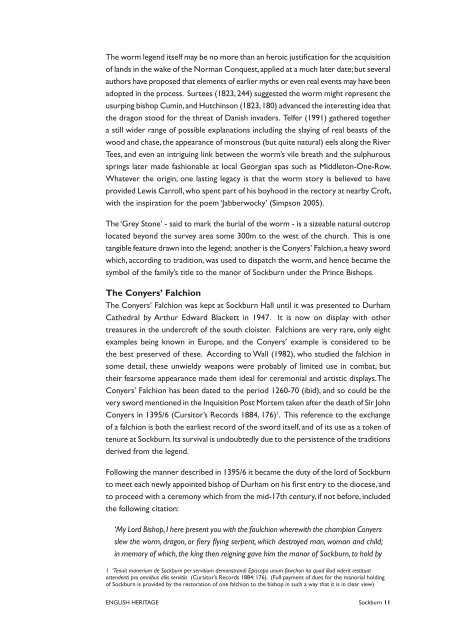Sockburn Hall, Darlington: an archaeological ... - English Heritage
Sockburn Hall, Darlington: an archaeological ... - English Heritage
Sockburn Hall, Darlington: an archaeological ... - English Heritage
Create successful ePaper yourself
Turn your PDF publications into a flip-book with our unique Google optimized e-Paper software.
The worm legend itself may be no more th<strong>an</strong> <strong>an</strong> heroic justification for the acquisition<br />
of l<strong>an</strong>ds in the wake of the Norm<strong>an</strong> Conquest,applied at a much later date;but several<br />
authors have proposed that elements of earlier myths or even real events may have been<br />
adopted in the process. Surtees (1823, 244) suggested the worm might represent the<br />
usurping bishop Cumin,<strong>an</strong>d Hutchinson (1823,180) adv<strong>an</strong>ced the interesting idea that<br />
the dragon stood for the threat of D<strong>an</strong>ish invaders. Telfer (1991) gathered together<br />
a still wider r<strong>an</strong>ge of possible expl<strong>an</strong>ations including the slaying of real beasts of the<br />
wood <strong>an</strong>d chase, the appear<strong>an</strong>ce of monstrous (but quite natural) eels along the River<br />
Tees, <strong>an</strong>d even <strong>an</strong> intriguing link between the worm’s vile breath <strong>an</strong>d the sulphurous<br />
springs later made fashionable at local Georgi<strong>an</strong> spas such as Middleton-One-Row.<br />
Whatever the origin, one lasting legacy is that the worm story is believed to have<br />
provided Lewis Carroll,who spent part of his boyhood in the rectory at nearby Croft,<br />
with the inspiration for the poem ‘Jabberwocky’ (Simpson 2005).<br />
The ‘Grey Stone’ - said to mark the burial of the worm - is a sizeable natural outcrop<br />
located beyond the survey area some 300m to the west of the church. This is one<br />
t<strong>an</strong>gible feature drawn into the legend; <strong>an</strong>other is the Conyers’ Falchion,a heavy sword<br />
which, according to tradition, was used to dispatch the worm, <strong>an</strong>d hence became the<br />
symbol of the family’s title to the m<strong>an</strong>or of <strong>Sockburn</strong> under the Prince Bishops.<br />
The Conyers’ Falchion<br />
The Conyers’ Falchion was kept at <strong>Sockburn</strong> <strong>Hall</strong> until it was presented to Durham<br />
Cathedral by Arthur Edward Blackett in 1947. It is now on display with other<br />
treasures in the undercroft of the south cloister. Falchions are very rare, only eight<br />
examples being known in Europe, <strong>an</strong>d the Conyers’ example is considered to be<br />
the best preserved of these. According to Wall (1982), who studied the falchion in<br />
some detail, these unwieldy weapons were probably of limited use in combat, but<br />
their fearsome appear<strong>an</strong>ce made them ideal for ceremonial <strong>an</strong>d artistic displays.The<br />
Conyers’ Falchion has been dated to the period 1260-70 (ibid), <strong>an</strong>d so could be the<br />
very sword mentioned in the Inquisition Post Mortem taken after the death of Sir John<br />
Conyers in 1395/6 (Cursitor’s Records 1884, 176) 1 . This reference to the exch<strong>an</strong>ge<br />
of a falchion is both the earliest record of the sword itself, <strong>an</strong>d of its use as a token of<br />
tenure at <strong>Sockburn</strong>.Its survival is undoubtedly due to the persistence of the traditions<br />
derived from the legend.<br />
Following the m<strong>an</strong>ner described in 1395/6 it became the duty of the lord of <strong>Sockburn</strong><br />
to meet each newly appointed bishop of Durham on his first entry to the diocese, <strong>an</strong>d<br />
to proceed with a ceremony which from the mid-17th century, if not before, included<br />
the following citation:<br />
‘My Lord Bishop, I here present you with the faulchion wherewith the champion Conyers<br />
slew the worm, dragon, or fiery flying serpent, which destroyed m<strong>an</strong>, wom<strong>an</strong> <strong>an</strong>d child;<br />
in memory of which, the king then reigning gave him the m<strong>an</strong>or of <strong>Sockburn</strong>, to hold by<br />
1 ‘Tenuit m<strong>an</strong>erium de <strong>Sockburn</strong> per servitium demonstr<strong>an</strong>di Episcopo unum fawchon ita quod illud viderit restituat<br />
ostendenti pro omnibus aliis servitiis (Cursitor’s Records 1884: 176). (Full payment of dues for the m<strong>an</strong>orial holding<br />
of <strong>Sockburn</strong> is provided by the restoration of one falchion to the bishop in such a way that it is in clear view)<br />
ENGLISH HERITAGE <strong>Sockburn</strong>

















